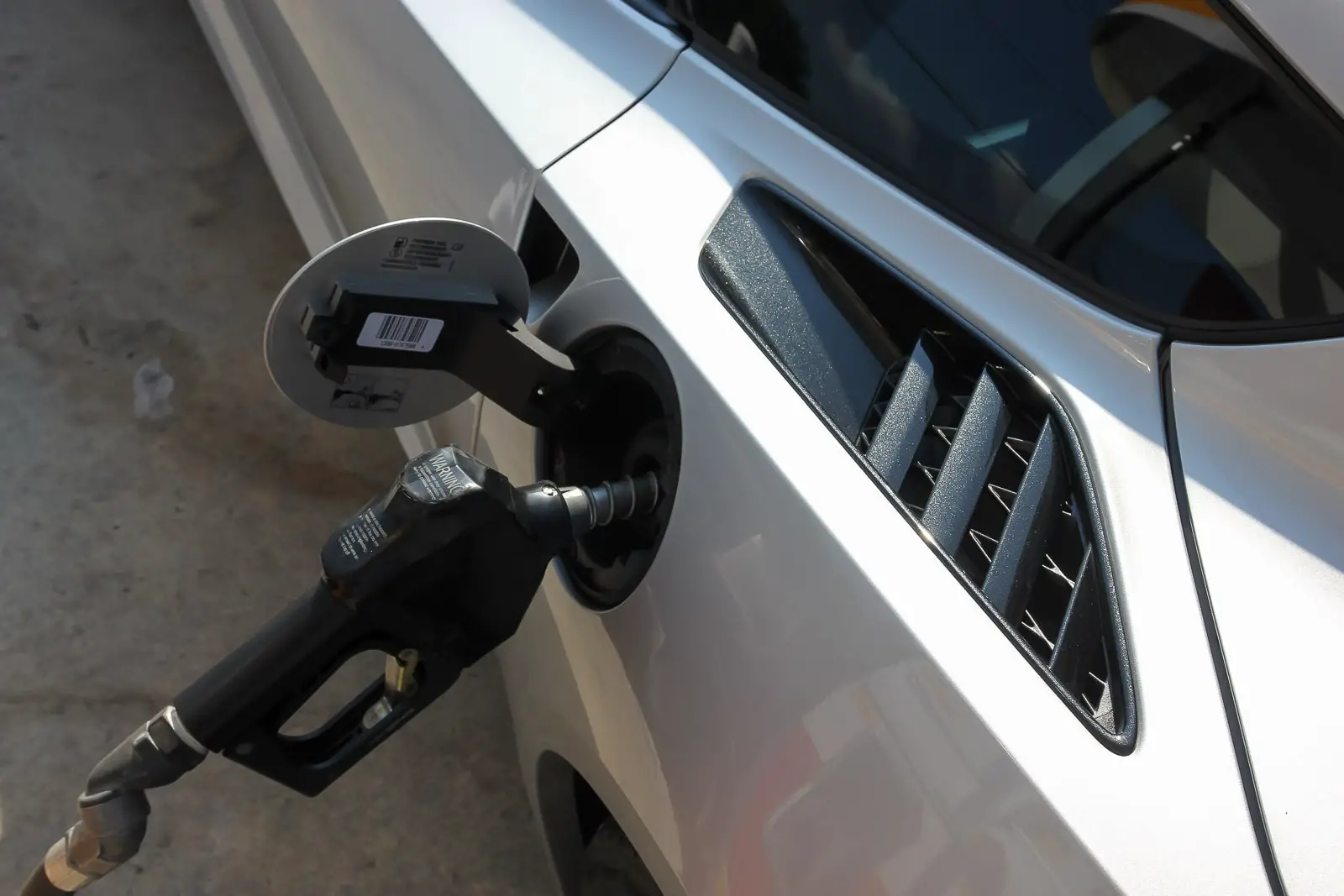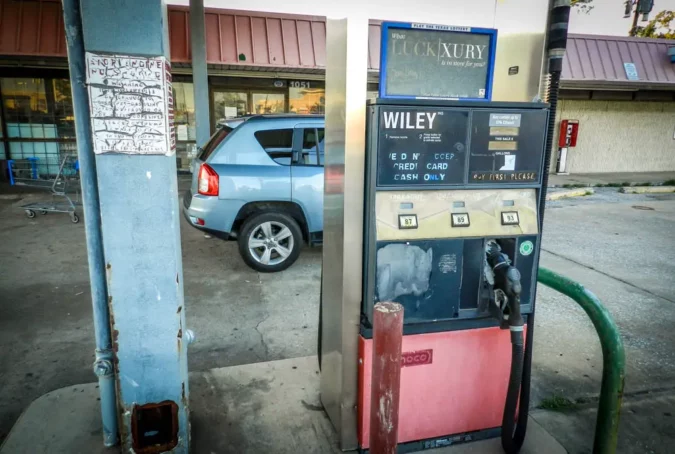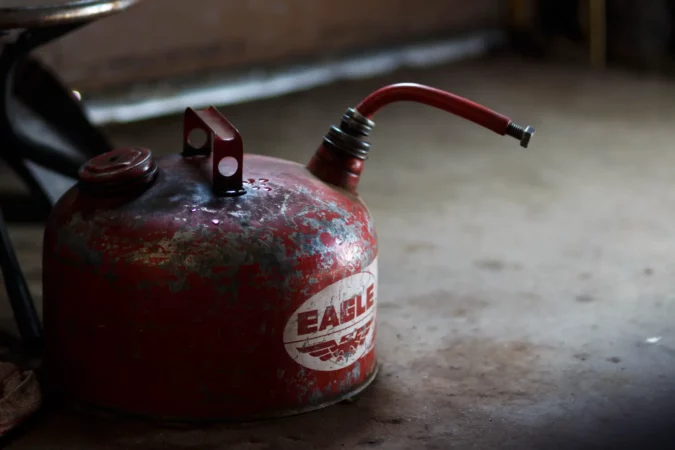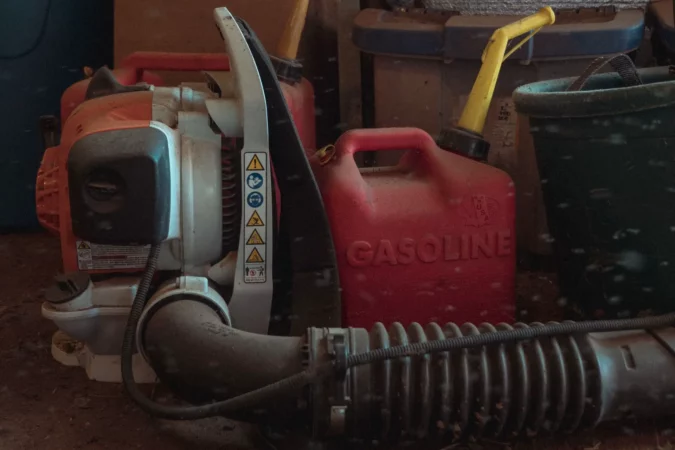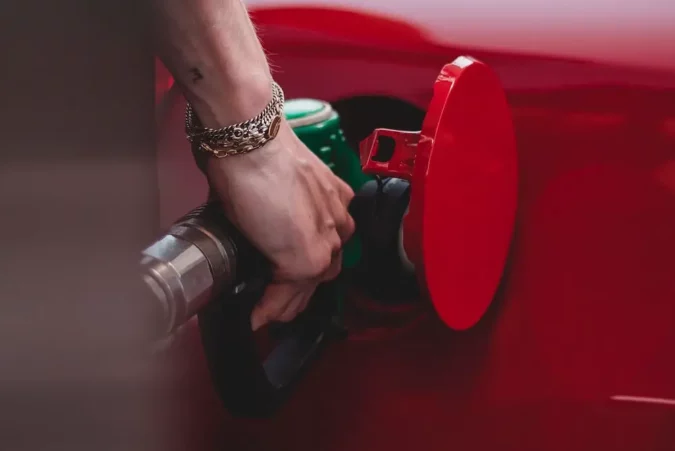Visiting the gas station is a regular activity for most drivers. You pull up to the pump, open the fuel cap, attach the nozzle, and let the car fill up. But, have you ever spared a moment to think about the fuel you are pumping in? Have you ever wondered “what color is gasoline?” If so, you have come to the right place.
Today, we’ll be taking a closer look at the color of gasoline. Not only that, but we will talk about some more important aspects of vehicle fuel – including the different types of gasoline (in addition to the different types of fuel), different shades of it, and what causes it to go bad.
We know that you are itching to get started, so let’s not waste any more time. Let’s start off by taking a look at the various types of gas available on the market.
Types Of Gas For Cars
When looking for the answer to “what color is gasoline?” it is important to have an idea about the different types of fuel available on the market. Yes, you heard that right! There is more than one type of gasoline you can pump into your car, and they all have different colors. A few different types of gas you are bound to come across include,
- Leaded Gasoline
- Unleaded Gasoline
- Regular Gasoline
- Mid-Grade Gasoline
- Premium Gasoline
- Flex Fuel
- 93 Octane Gasoline
- 95 Octane Gasoline
- E15 Gasoline
Before looking at their colors, let us understand what separates gasoline into these types first.
Types Of Gas For Cars #1 – Leaded Gasoline
Let’s start off our conversation by taking a look at the oldest type of gasoline known to motorists. We are of course talking about leaded gasoline.
Leaded gas has a history that runs back to 1921. This was the year when gasoline mixed with lead additives was made available on the market. The main goals of this practice were limiting engine knock, improving engine performance as well as getting better fuel economy.
For a time, leaded fuel was the only type of gasoline available for sale. However, by 1969, the public would come to realize the hidden dangers of leaded gasoline. The fumes released by the combustion of leaded gasoline caused massive health and environmental hazards.
With these discoveries, motoring authorities around the world took action to phase out the use of leaded gasoline, while also looking for better alternatives. In 1986, Japan became the first country to ban the use of leaded fuels. In contrast, Algeria was the last to do so, continuing to use leaded fuel until 2021.
You might wonder why this change took nearly 5 decades to complete. Well, you see, engines designed to run on leaded fuel cannot function on unleaded gas. So, unleaded fuel had to be phased out instead of being banned outright.
Types Of Gas For Cars #2 – Unleaded Gasoline
Unleaded fuel was the answer to the dangerous leaded fuels. It does not contain tetraethyl lead, which is the component that made leaded gasoline so dangerous in the first place.
In addition to getting rid of tetraethyl lead, vehicle manufacturers used other tactics to reduce harmful emissions as well. This includes the implementation of catalytic converters, which have since become a mandatory component.
In this day and age, all types of gasoline sold at fuel stations are of the unleaded variety.
Types Of Gas For Cars #3 – Regular Gasoline
When talking about different types of gas for cars, you are bound to come across the term “Octane level” But, do you know what it is?
Octane is used to measure several aspects of fuels such as quality, performance, and burning efficiency. Generally, the higher the octane level, the better the fuel will be.
Regular gasoline is often the cheapest type of gas available at fuel stations. It has an octane level of 87, making it the lowest octane fuel on offer.
Due to the low octane level, regular gasoline burns in an unpredictable way under high compression levels. Additionally, it lacks the performance characteristics offered by higher octane-level fuels. This is why some wonder whether can you put premium gas in any car that uses regular.
However, there are some disadvantages of pumping low-octane fuels into your car as well. The spontaneous ignition of this fuel can cause damage to the engine’s internals. But, most modern engines compensate for this by adjusting the spark timing with the use of computer-controlled ignition.
Types Of Gas For Cars #4 – Mid-Grade Gasoline
Mid-grade gasoline sits above regular gasoline in price, performance, and fuel efficiency. Typically, 89-octane gasoline is considered mid-grade. However, there are some areas where mid-grade gasoline is 90-grade.
Thanks in part to the higher octane count, mid-grade gasoline causes less wear and tear on the engine internals when compared to regular gas. Most vehicle manufacturers recommend the use of 89-grade gasoline in their engines.
Although engines designed to run on mid-grade gasoline can function on 87-octane fuel, there will be a noticeable drop in both fuel efficiency and performance. On the other hand, filling up vehicles designed to run on low-octane fuel with mid-grade gasoline would not grant any increases in fuel efficiency or performance.
Types Of Gas For Cars #5 – Premium Gasoline
Gasoline with an octane grade between 91 and 93 is called premium gasoline. This is the most expensive fuel you can at your local gas station. As you might have guessed, there are many benefits to using premium gasoline.
Due to the higher octane count, premium gasoline does not have a tendency for spontaneous ignition, which makes internal engine components last longer.
Additionally, premium gasoline enables the engine to create more power, and it gives better fuel economy too.
If you drive a vehicle with a high-performance engine, we recommend you always go for premium gasoline. As we mentioned several times, using lower-octane fuels with high-performance engines is a recipe for disaster, which can end up costing you thousands of dollars in repair bills.
Types Of Gas For Cars #6 – Flex Fuel
Up to this point, all types of gasoline we discussed were obtained from refined crude oil. However, this is not the case with flex-fuel. Some people also use the term E85 to refer to this type of gasoline.
But, when talking about what color is gasoline, it would be a crime not to talk about flex fuel too. It is created by blending ethanol and gasoline together. The ethanol composition in E85 fuel can range between 51% to 83%. Additionally, this amount can also be changed depending on the climate and season.
However, it is important to note that not all vehicles can run on flex fuel. The engine and fuel system have to be adapted to allow the vehicle to perform as intended. Such vehicles are called Flexible Fuel Vehicles, or FFVs for short. In fact, vehicles running E85 can produce more power and torque when compared to their pure gasoline-fueled counterparts.
Yet, there are some drawbacks of flex-fuel too. The biggest drawback of E85 is fuel efficiency. On average, FFV vehicles consume between 15% to 27% more fuel when compared to gasoline-powered ones. The low energy per volume of ethanol is the main cause behind this problem.
For more context into ethanol-based fuels, check out our guides on whether can you mix E85 with regular gas, in addition to looking into ethanol-free gas.
Types Of Gas For Cars #7 – 93 Octane Gasoline
When taking octane levels into consideration, 93 octane gasoline ranks even above premium gas. Super-premium and ultra-premium are two names people use to refer to this fuel.
93 octane fuel is mainly used in high-performance engines. These power plants have high compression rations, which can cause engine damage if lower octane fuels are used. Not only that, but high-performance fuel injectors that come in these engines also require the use of premium fuels like 93-octane gasoline.
Types Of Gas For Cars #8 – 95 Octane Gasoline
If you want the absolute best gasoline out there, you’ll have to spend some serious money and get yourself a tank full of 95-octane gasoline. The use of this fuel is recommended by high-end luxury car manufacturers for better performance and longevity.
But, even if you don’t have a Ferrari or an Aston Martin sitting in your garage, there are still cases where using 95-octane gasoline is recommended. That is if you live in coastal regions. In contrast, the slightly cheaper 93-octane performs better at higher altitudes.
Types Of Gas For Cars #9 – E15 Gasoline
E15 gasoline is the final type of car gas we’ll be taking a look at today. It is produced by blending 15% ethanol with 85% gasoline. This is comparable to 88-octane gasoline. It is also the reason why some gas stations sell E15 fuel as “unleaded 88-octane” gasoline.
The letter “E” in E15 indicates that the gasoline has been blended with ethanol to create the end product.
Here, ethanol may be used as either an alternate fuel or an additive.
Most vehicles produced after the dawn of the new millennium can run on E15 without requiring any modifications. However, this excludes vehicles like motorcycles, ATVs, and snowmobiles.
Now that you know all about the different types of fuel available for cars, let’s shift our attention toward what gives them their distinct colors.
Gasoline Color
We know that you have plenty of experience in visiting and fueling up your car at gas stations. But, have you ever seen the gasoline that runs through the pump? We bet that most of you have never seen it. So, what color is gasoline?
To find out the answer, let’s first take a look at where it comes from. As you might already know, the fuel we know as gasoline is a derivative of crude oil. In order to obtain gasoline, the crude oil has to be refined through a process called “fractional distillation.”
Along with gasoline, diesel, kerosene, and motor oil also originate from crude oil. Contrary to popular belief, crude oil is not black in color. Instead, it has a hue that is a combination of dark brown and black. Depending on where the crude oil is sourced from, it can appear red or green too.
In its purest form, gasoline distilled from crude oil is colorless. However, this translucent liquid is not what we pump into our gas tanks (so long as you don’t mistakenly wonder what happens if you put gas in a diesel engine). How does that happen?
You see, pure gasoline is mixed with different additives and dyes before they make it to the duel station. The addition of dyes is mainly done for easier identification. Typically, commercial-grade gasoline has a slight yellowish hue. However, it can look green or orange under certain lighting conditions as well.
There are some parts of the world where the color of gasoline varies depending on its octane level.
What Color Is Gasoline #1 – Regular Gasoline
We already told you what regular gasoline is, as well as its common characteristics. This type of gasoline usually has a greenish hue. On some occasions, it can have a slight, blueish tint as well.
What Color Is Gasoline #2 – Mid-Grade Gasoline
As we have established, the octane level of mid-grade gasoline is 89. Due to the addition of yellow dye, it appears yellowish to the human eye.
What Color Is Gasoline #3 – Premium Gasoline
The most expensive type of gasoline – premium has a distinct pinkish hue that differentiates it from other types of gasoline. This is also due to the addition of pink dye to the fuel.
What Color Is Gasoline #4 – Diesel
If you own a heavy-duty truck, you would be more interested in knowing about the color of diesel instead of gasoline. Diesel is brown, with a hint of green mixed in. But, this is not the only type of diesel out there.
You can also purchase diesel that is red in color. It is typically used in agricultural machines, as well as in tractors. Not only that, but red diesel is also cheaper in price. But, don’t get excited just yet. Apart from the two vehicle types we discussed, running any other vehicle on red diesel is prohibited by the law.
What Color Is Gasoline #5 – Bio Diesel
Due to the recent hike in fuel prices, biodiesel has also seen a hike in popularity. This special type of environmentally friendly diesel is made using raw materials like animal fats, vegetable oil, or even soybean oil.
These materials undergo a complex chemical process, with the end product being a golden brown fuel. But, keep in mind that the color can change depending on how the bio-diesel is produced.
Signs Of Bad Gas In Car
Although you might think that the color of gasoline simply does not matter, there are some occasions where knowing the exact color comes in handy. While it is true that the color isn’t important when the gasoline is fresh, it is important to keep an eye on it as the gas gets older.
As gasoline gets older, its appearance will begin to change due to oxidation. During oxidation, the gasoline combines with oxygen particles present in the atmosphere. Over time, the yellowish tint of gasoline will change to a brownish hue.
Are you wondering whether your car is running on bad gasoline? Here are some signs you can use to identify it.
- Check Engine Light Turning On
- Startup Issues
- Stalling
- Poor Acceleration
- Bad Fuel Economy
What Color Is Gasoline, Signs Of Bad Gas #1 – Check Engine Light Turning On
The check engine light is one of the first indications that indicates a potential issue with your engine. Bad gasoline is just one of the many reasons that can cause this warning light to illuminate.
If you suspect that bad gasoline is to blame, try filling up your car at a different gas station. If gasoline was the culprit behind the issue, the check engine light will go away on its own after one or two fresh tanks of fuel.
Otherwise, you can check out our guides on what to do about the check engine light below:
- How to turn off the check engine light
- What to do about a blinking check engine light
- How to reset a check engine light
- What does a ‘gas cap’ check engine light mean
- Why is the check engine light flashing
- Is your check engine light blinking and the car is shaking
- Why your check engine light comes on and off
- What to do when the check engine light comes on
What Color Is Gasoline, Signs Of Bad Gas #2 – Startup Issues
There are several issues that can cause your vehicle to struggle during startup. This will especially be evident once you go to start a car that has been parked for a long time. If the gasoline inside the fuel tank has vastly degraded, it might not be combustible enough to turn the engine over.
What Color Is Gasoline, Signs Of Bad Gas #3 – Stalling
Frequent engine stalls are another common symptom of bad gasoline inside the fuel tank. Similar to the startup issues we discussed, engine stalls also happen due to the fuel not being combustible enough.
What Color Is Gasoline, Signs Of Bad Gas #4 – Poor Acceleration
Diluted fuel may hamper the acceleration characteristics of a vehicle. Acceleration requires the engine to create a sudden burst of power, which means that the gasoline has to be very combustible for the best acceleration.
https://youtu.be/AC9pxlSjA5Q
But, as we have already established, diluted gasoline is not that combustible. So, the vehicle won’t accelerate as you desire. Additionally, if the car is running on bad gasoline, you might feel sudden surges of power as well. This happens when there is a mixture of old and new gasoline inside the fuel tank.
What Color Is Gasoline, Signs Of Bad Gas #5 – Bad Fuel Economy
Poor fuel economy is the final symptom you can use to identify bad gasoline inside the fuel tank. Once again, this issue links to the reduced computability of bad gasoline. Due to the poor quality, the gasoline won’t be as efficient as before, resulting in you getting fewer miles to the gallon.
We must also mention the fact that continuing to run your vehicle on bad gasoline can cause significant damage to its fuel system.
Bad Gas Treatment
There are special fuel additives available on the market that can help get rid of bad gasoline. These additives contain different chemicals such as ethanol, methanol, and isopropyl alcohol, all at different concentrations. These additives are especially useful in removing water from gas tanks.
WD-40 is another useful chemical when it comes to removing contaminants from gasoline. Not only that, but it is also effective in preventing the corrosion of gas tanks as well.
If you need to learn more, we’ve previously covered a lot about bad gasoline, so do consider checking out our write-ups below:
- How to get rid of bad gas in your car
- How to dispose of old gas
- Can bad gas cause a misfire
- How to treat bad gas in a car
Conclusion To What Color Is Gasoline
At the end of the day, we can safely say that knowing the color of gasoline has several benefits. All kinds of gasoline are yellow in color, but they can have different colored dyes added to them.
Regular gasoline is green in color, while mid-range gasoline looks closer to yellow. On the other hand, premium gas looks pink, making it easily distinguishable.
FAQs For What Color Is Gasoline
Here are some popular FAQs:
Does Gasoline Go Bad
The time in which gasoline goes bad changes depending on the specific type. Regular gasoline has an average shelf life of between three to six months. On the other hand, the shelf life of diesel is around one year. After that period passes, the fuel begins to oxidize, which degrades its combustibility.
What Color Is Gas
Regular gasoline is greenish in color, while mid-grade gas has a yellowish hue. Premium gasoline is pink in color, while diesel is brown with a hint of green. If the gasoline has gone bad, you will be able to easily identify it by its dark appearance.
How Long Is Gas Good For In A Gas Can
If you plan to store gasoline for a long time, store it in a plastic or metal container that is properly sealed. Doing so allows the gasoline to stay fresh for between three to six months. In contrast, gasoline inside a vehicle’s fuel tank will start to break down in under a month.
How To Tell If Gas Is Bad
There are several ways in which you can identify bad gasoline. The first method is by appearance. Bad gasoline is darker in color when compared to the yellowish tint of fresh gasoline. In addition, bad gasoline carries an unpleasant smell as well. If you suspect that the fuel has gone bad, get rid of it and fill your gas tank with some fresh gasoline.
What Does Water In Gas Look Like
Water contamination severely decreases the performance of gasoline. There are several symptoms that you can use to identify whether water has mixed with gasoline inside your fuel tank. These include performance issues, engine hesitation, misfires, rough idling, and issues with starting the engine.
How Long Does Stabilized Gas Last
Gasoline stabilizers are made from petroleum products, and they prevent the gas from evaporating. This allows stabilized gasoline to last longer than its regular counterpart. If stored correctly under ideal conditions, stabilized gasoline has a shelf life of between one and three years.

